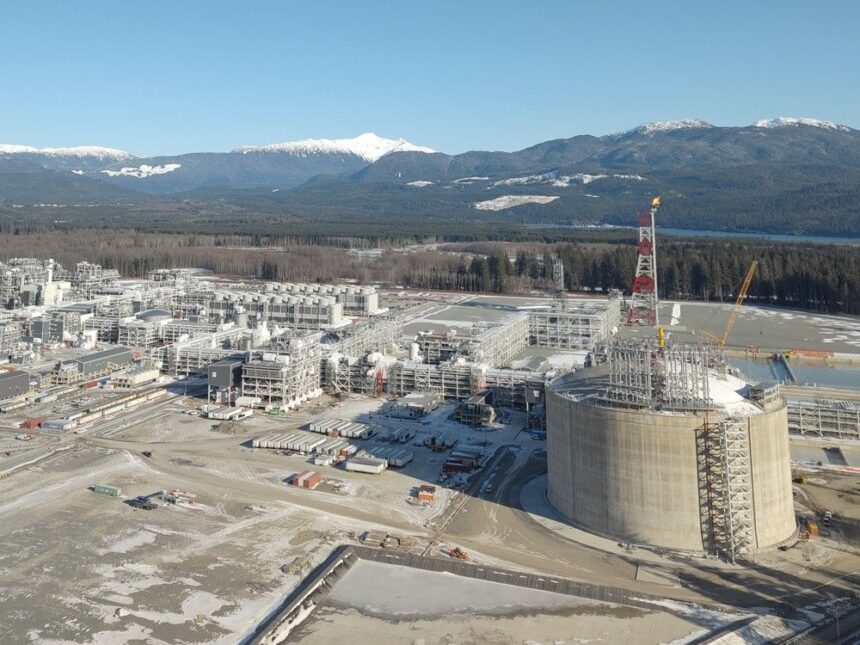The morning fog hung thick over Kitimat’s Douglas Channel as I watched workers in hard hats and safety vests move purposefully around the massive LNG Canada construction site. Behind them, the framework of what will become Canada’s largest liquefied natural gas export facility stretched toward the sky — a $40 billion bet on the future of fossil fuels in a world increasingly concerned about climate change.
“We believe this project can help reduce global emissions,” explained Sarah, an environmental engineer at the site who requested I use only her first name. “Natural gas is cleaner than coal, and countries like China and India need cleaner options while they transition to renewables.”
This narrative — that Canadian LNG represents a climate solution rather than a problem — has become the central argument for an industry expanding against the backdrop of urgent climate warnings. But like the fog that periodically obscures the mountainous British Columbia coastline, the relationship between Canadian LNG exports and global emissions is anything but clear.
For communities like Kitimat and the Haisla Nation, whose traditional territory hosts the facility, the project represents economic opportunity. Crystal Smith, Chief Councillor of the Haisla Nation, has repeatedly expressed support for the development, noting that the partnership has brought unprecedented economic benefits while maintaining environmental standards higher than those found in competing jurisdictions.
“Our people have lived on this land for thousands of years,” Smith told me during a previous interview. “We understand the need to balance economic development with environmental protection. We believe this project achieves that balance while creating opportunities our community has never had before.”
The technical argument for LNG as a climate-positive export hinges on displacement. When exported to markets like China, Japan, or India, Canadian natural gas could replace coal-fired electricity generation, potentially reducing emissions by 40-50% per unit of energy produced. Environment and Climate Change Canada has acknowledged this displacement effect, though it stops short of claiming definitive climate benefits.
At the University of Calgary’s School of Public Policy, researcher Sara Hastings-Simon offers a more complex view. “The reality is that natural gas might displace coal in some contexts, but it could also displace renewables or simply add to total energy consumption,” she explains. “We need to be honest about these dynamics rather than assuming the best-case scenario.”
Her research indicates that for Canadian LNG to deliver meaningful climate benefits, four conditions must be met: the gas must primarily replace coal rather than renewables; methane leakage must be minimized throughout the production and transport process; the energy-intensive liquefaction process must be powered by clean electricity; and policies must ensure gas is a bridge fuel rather than a destination.
Walking along the waterfront in Prince Rupert, where additional LNG terminals have been proposed, I met James Wilson, a commercial fisherman whose family has harvested these waters for generations. His weathered hands gestured toward the horizon as tanker traffic concerns surfaced in our conversation.
“The politicians talk about emissions in other countries, but what about what happens here?” he asked. “More tankers, more pipelines, more fracking up north. We’re already seeing changes in our waters from climate change. More acidic oceans, changing salmon runs.”
Wilson’s concerns highlight a crucial accounting issue. Under international agreements, emissions from burning exported fuels don’t count toward Canada’s national totals — only the emissions from production and processing within our borders. This creates a potential blind spot where Canada can claim climate leadership while expanding fossil fuel exports.
According to the Pembina Institute, a clean energy think tank, full lifecycle emissions from the LNG Canada project alone could reach 93 million tonnes of CO2 equivalent annually when overseas combustion is included — roughly equivalent to 13% of Canada’s entire annual emissions. Only about 13 million tonnes would be counted in Canada’s domestic inventory.
Mark Jaccard, professor at Simon Fraser University’s School of Resource and Environmental Management, suggests we need to move beyond simplistic either/or thinking. “The climate benefit of gas depends entirely on the policies in receiving countries,” he explains. “If they have binding emissions caps or escalating carbon prices, then gas might serve as a transition fuel. Without those policies, adding any fossil fuel to the global mix just makes the problem worse.”
The Intergovernmental Panel on Climate Change has emphasized that limiting warming to 1.5°C requires steep reductions in all fossil fuels, including natural gas. Their 2022 report notes that while gas produces fewer emissions than coal when burned, methane leakage during production and transport can significantly erode this advantage. Methane traps approximately 86 times more heat than carbon dioxide over a 20-year period.
Back in Kitimat, I visited the Haisla Nation’s community center, where photographs of traditional territory hang alongside maps showing the LNG facility. The juxtaposition captures the complicated reality for many Indigenous communities navigating resource development decisions.
Matthew Moccasin, a Haisla elder I spoke with while visiting the community, offered a perspective that doesn’t fit neatly into pro or anti-LNG categories. “Our people have always used the resources of our territory,” he said. “But we’ve also always thought about the future. Seven generations ahead. These are difficult choices for us.”
The seven generations principle Moccasin references raises questions about locking in fossil fuel infrastructure that could operate for decades. With most of the world’s nations committed to reaching net-zero emissions by mid-century, new LNG facilities might face stranded asset risks if demand drops faster than industry projections suggest.
Canada’s Natural Resources ministry maintains that global demand for LNG will continue growing until at least 2040, with Asian markets driving much of this increase. Officials point to the International Energy Agency’s stated need for natural gas during the energy transition.
However, that same agency released a bombshell report in 2021 concluding that no new oil and gas fields should be developed if the world hopes to reach net-zero by 2050. This apparent contradiction illustrates the dueling narratives about natural gas — either as transition fuel or climate problem.
On a practical level, Canada faces competition in the global LNG market from major exporters like Qatar, Australia, and the United States, all of which have expanded capacity significantly. This competition raises questions about whether Canadian projects will find sufficient market space, especially as renewable energy costs continue to fall.
“The economics of LNG are as complicated as the emissions math,” explains Werner Antweiler, professor at the University of British Columbia’s Sauder School of Business. “These projects require billions in upfront investment and decades to recoup those costs. The window for profitability might be narrowing as the world accelerates toward decarbonization.”
For Canadians living near production zones in northeastern B.C., the debate often centers on more immediate impacts. Hydraulic fracturing operations — the primary source of gas for LNG exports — have raised concerns about water usage, induced seismicity, and local air quality.
Angela Carter, associate professor at the University of Waterloo and author of research on Canada’s fossil fuel policies, argues that the focus on international emissions benefits often obscures domestic impacts. “We need to consider the full spectrum of environmental and social effects,” she says. “The gas has to come from somewhere, and those upstream impacts matter tremendously to the people living with them.”
As I prepared to leave Kitimat, the morning fog had lifted, revealing the spectacular coastal mountains that frame this industrial town. The clarity seemed momentarily symbolic — yet the more I learned about Canadian LNG and its complex relationship with global emissions, the more I recognized that simple answers remain elusive.
What’s clear is that Canada’s LNG strategy represents a substantial wager on the future of natural gas in a rapidly decarbonizing world. Whether that wager pays off — for investors, communities, and the climate — depends on factors ranging from international climate policies to technological developments to evolving energy markets.
For now, construction continues in Kitimat, methane continues to flow from northeastern B.C. wells, and communities along the gas pathway continue navigating the tensions between economic opportunity and environmental concern. The fog, it seems, hasn’t fully lifted after all.






